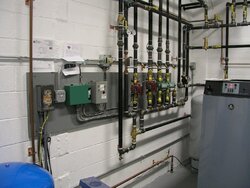Power went out today when I had a nice fire going and temp went crazy. My fires are hot with the briquets I burn so I'm concerned when leaving for the day. I know my over heat loop is undersized and gravity feed doesn't move enough water so I want to add a circulator to move the water faster. I am going to add more commercial fin tube to help the situation. My question is, I want to put a battery backup to run the circulator on the loop but I'm not sure how to hook that up.What is the switching device to activate that? OR can I set all the controls and circ's to work off the back up?
Anybody have setups like this?
Anybody have setups like this?


